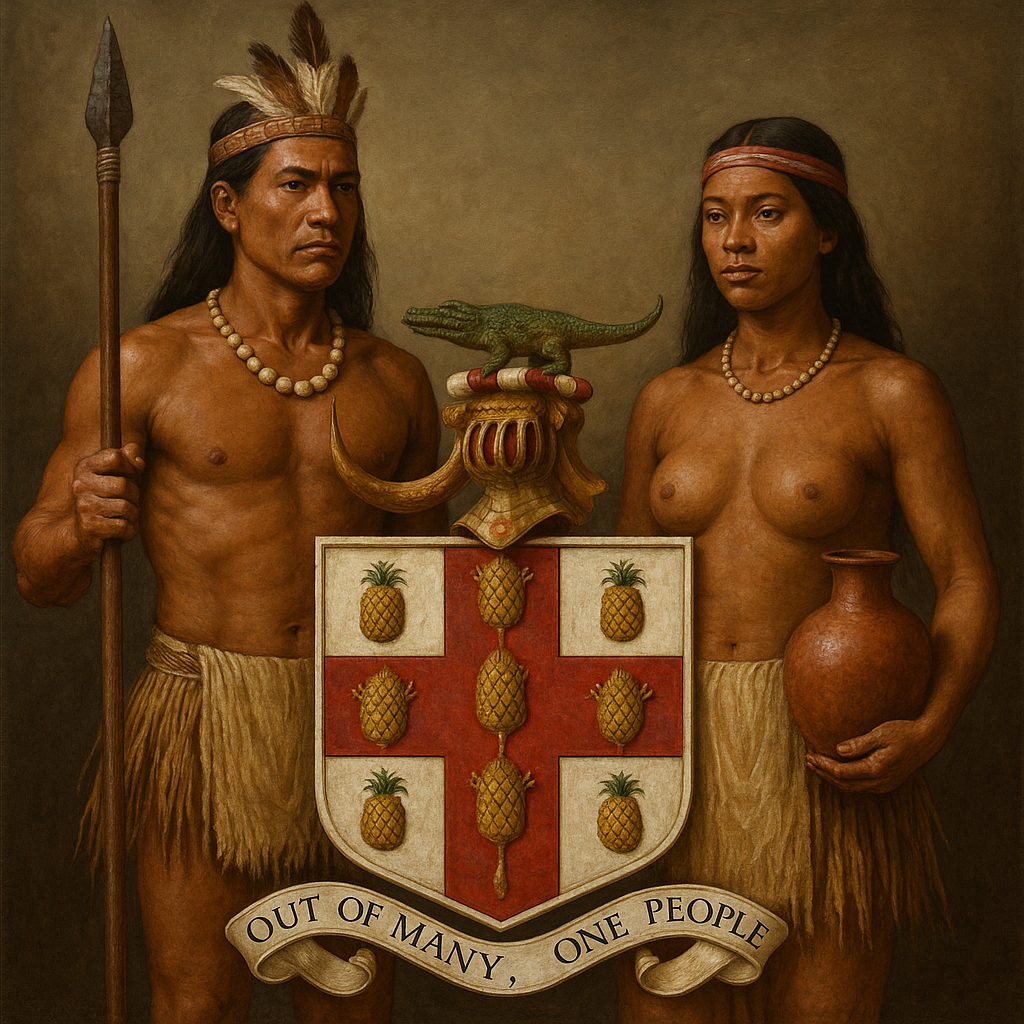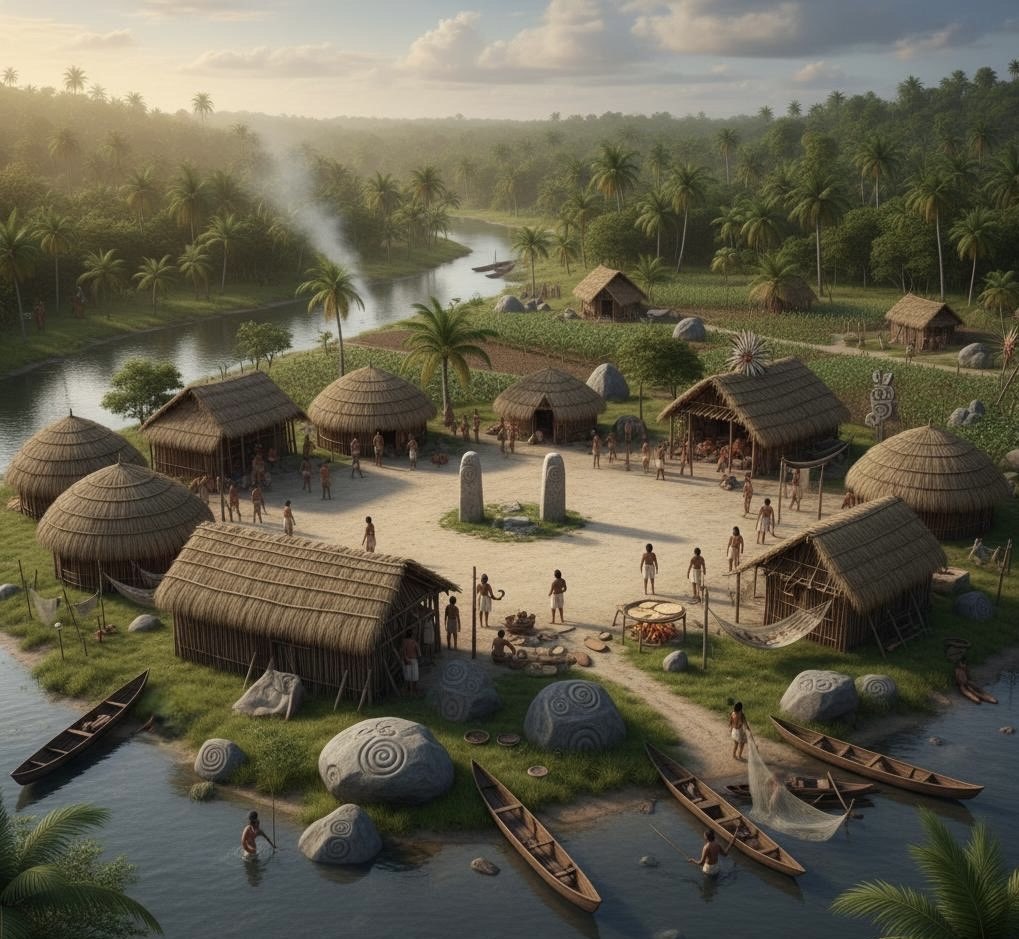Your cart is currently empty!

Honoring Jamaican Tainos
Why I Don’t Recognize Columbus Day.
I remember being taught as a young child about the fearless adventurer Christopher Columbus who traversed the unknown to “discover” the “New World”, including Jamaica. He was celebrated for:
- Linking Worlds: he introduced new plants, animals, and technologies between continents (the so-called Columbian Exchange).
- Globalization Roots: he set the stage for today’s interconnected world, with travel and cultural exchange across oceans.
- Navigation Advances: he pushed forward European knowledge of navigation and geography.
By the time I got to high school, our education system had started to shed the residues of our colonial history, and I learned much more about the original inhabitants of Jamaica (the Tainos) and what happened to them at the hands of Columbus and his men. Christopher Columbus’s arrival in the Caribbean in 1492 marked the beginning of European empire-building in the Americas. What followed was the rapid colonization of indigenous lands, the forced establishment of European dominance, and the violent pursuit of gold and resources. This process included enslavement, displacement, and the devastation of local populations and cultures.
- Genocide and Depopulation: In some regions, up to 80–95% of the native population perished within 150 years of Columbus’s arrival, as a result of violence, forced labor, and new diseases like smallpox and measles, to which indigenous people had no immunity.
- Slavery and Atrocities: Columbus and his men enslaved thousands of indigenous people. Many were sent to Spain as slaves; others were forced to mine for gold. Women and children were not spared: there are records of girls as young as nine being sold into sexual slavery.
- Colonial Exploitation: The conquest of these lands was brutal and set a pattern for future European expansion: systematic conquest, destruction of societies, loss of languages, and forced adoption of European religion and culture (Christianity was imposed and local beliefs suppressed).
Columbus’s actions were backed by the Spanish crown’s desire to build a global empire, seeking not only wealth but dominance over people, economies, and belief systems. This laid the groundwork for centuries of colonial rule, the transatlantic slave trade, and cultural erasure throughout the Caribbean and the Americas.
Sometimes when this comes up in conversation, I’m told that this was the reality of the times. Columbus and his men were doing what was considered natural and normal for that era. But in my experience, if you look hard enough you find the voices of conscience who spoke out against the atrocities. People knew even then that what they were doing was wrong.
One of these voices was Bartolome de las Casas who said: “What we committed in the Indies stands out among the most unpardonable offenses ever committed against God and mankind [and this trade in Indian slaves] as one of the most unjust, evil and cruel among them…Their reason for killing and destroying such an infinite number of souls is that the Christians have an ultimate aim, which is to acquire gold, and to swell themselves with riches in a very brief time and thus rise to a high estate disproportionate to their merits…. It should be kept in mind that their insatiable greed and ambition, the greatest ever seen in the world, is the cause of their villainies.”
The other reality is that empire building, slavery, genocide, and exploitation of people and lands continue to this day. They never left us. Columbus has simply morphed into certain technocrats, politicians, multinationals, and others driven by greed.

The Taínos, Jamaica’s indigenous people, offer a wealth of documented cultural values and practices that are relevant to work, life, and relationships today. I was helping my nephew study for a history exam recently. He (and I) were learning details about Taíno dress, food, politics, language and daily practices. They gave us the words “canoe”, “barbecue”, “hurricane”, “tobacco” and “hammock”. They had their own religion, represented by various symbols and artifacts.
Their examples of social harmony, respect for nature, communal effort, spirituality, and inclusive governance provide meaningful inspiration for contemporary living. What we know about Taino culture is worthy of application.
Taíno Cultural Characteristics Worth Emulating
- Community and Cooperation: Taíno villages were organized around collective wellbeing, with leaders (caciques) responsible for fairly distributing work and resources so everyone was cared for. Every member had a task, and social roles were clearly defined but collaborative. Daily life stressed unity, shared tasks, and support networks, sometimes with extended families occupying communal houses.
- Harmony and Peacefulness: The Taínos are remembered as friendly, happy, and gentle. They prioritized conflict resolution, using ceremonial ball games (batey) and music/dance gatherings (areytos), to address disputes and strengthen bonds between communities, rather than violence.
- Respect for Nature and Sustainable Living: The Taínos practiced sustainable agriculture, cultivating cassava and other crops in ways that preserved the land. They utilized natural resources carefully and held animistic spiritual beliefs, revering nature spirits (zemíes) and maintaining a balance with their environment. Their economic systems revolved around subsistence farming, fishing, and bartering, showing efficiency and low environmental impact.
- Spirituality and Celebration: Spiritual beliefs and ceremonies were woven into daily life. Music, dance, art, and ritual played essential roles in connecting with ancestors and nature, enhancing community vitality and resilience.
- Social Inclusion and Matrilineal Heritage: Leadership and inheritance followed maternal lines, emphasizing respect for women and an inclusive approach to governance. Caciques could be male or female, and leaders listened to advisers and spiritual guides, modeling participatory decision-making.
Implications for Work, Life, and Relationships
- Work: Emulating Taíno values encourages collaborative, purpose-driven workplaces, where everyone’s contribution matters and leaders focus on fairness. Shared leadership and task distribution foster trust, reduce burnout, and build resilience.
- Life: Prioritizing harmony, celebration, and connection to nature can boost wellbeing, mindfulness, and a sense of belonging. Sustainable living and respect for the environment can support personal growth and environmental responsibility.
- Relationships: Taíno inclusiveness – especially the power of kinship, matrilineal respect, and conflict resolution through dialogue and ceremonial practice – offers valuable lessons for strengthening families and communities. Practicing empathy, listening, and collective decision-making reinforces strong bonds.
By bringing Taíno heritage into everyday life, individuals and teams can cultivate balance, peace, and creative collaboration, while honoring ancestral wisdom and the principles of care for one another and the earth.
So on this Columbus Day, I will choose to reflect on the gentle and welcoming souls whose homes were invaded, whose land was stolen, and who were massacred under the guise of religion but really out of greed. The Tainos are not in my bloodline but they are part of my heritage as a Jamaican. Today, let’s remember the Jamaican Tainos and honor their memory. Let’s also remember the living Tainos who still uphold and spread the values of their great ancestors.

Leave a Reply